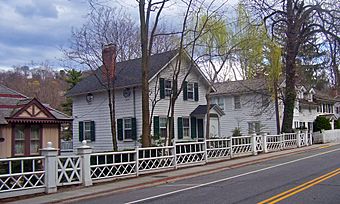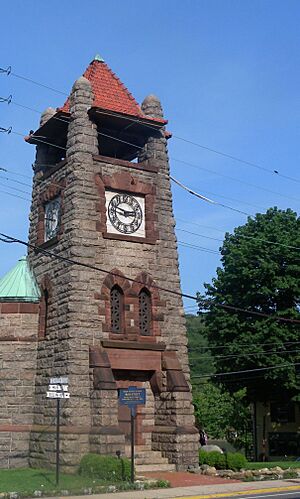Main Street Historic District (Roslyn, New York) facts for kids
Quick facts for kids |
|
|
Main Street Historic District
|
|

Houses on Main Street, 2008
|
|
| Location | Roslyn, NY |
|---|---|
| Nearest city | Glen Cove |
| Area | 40 acres (16 ha) |
| Built | 19th century |
| Architect | Thomas Wood, James K. Davis |
| Architectural style | Federal, Greek Revival |
| NRHP reference No. | 74001266 |
| Added to NRHP | 1974 |
The Main Street Historic District is a special area in Roslyn, New York. It's like a time capsule, showing how the village looked many years ago. This district is found along Main Street, stretching between North Hempstead Turnpike and East Broadway. It also includes parts of Tower Street, Glen Avenue, and Paper Mill Road.
Most of the buildings here are homes, but there are some shops at the northern end. Many of these houses were built in the 1800s, even before the Civil War. They show off cool building styles like Federal and Greek Revival. Even though the areas around Nassau County have grown a lot, Main Street has stayed pretty much the same. This historic district was officially recognized in the early 1970s and added to the National Register of Historic Places in 1974.
Contents
Exploring the Main Street Area
The Main Street area is surrounded by nature. To the east, you'll find the calm waters of Roslyn Pond. To the west, there are steep hills that rise up. There aren't many streets that cross Main Street here, except for Old Northern Boulevard. This natural separation has helped the district keep its old-fashioned charm and historic look.
In the early 1900s, a small park was created near Roslyn Pond. This was part of a project to control malaria, a disease spread by mosquitoes. The park even has a copy of Roslyn's very first paper mill, which is also part of the historic district.
A Look Back at Main Street's History
Roslyn was first settled in the mid-1600s and was known as Hempstead Harbor. It was a busy port that served nearby communities. The Main Street area is where this first settlement began. The oldest building in the district, part of the Van Nostrand-Starkins House, dates all the way back to 1680!
In 1700, the village's first gristmill (a mill for grinding grain) was built. Later, in the 1750s, Hendrick Onderdonk took over the mill. He was able to open a paper mill in 1773, which was the first big industry in the village. Around that time, the first house still standing on Main Street today (number 150 Main Street) was built by Wilson Williams, a cooper who worked for Onderdonk. Even George Washington stayed there in 1790, and he wrote about the two mills in his diary!
The 1800s saw a big increase in the number of houses along Main Street. Most of these homes were built by local builders or merchants. Only one, John Hendrickson's home at 110 Main, was designed to be a large estate, like those found elsewhere on Long Island's North Shore. A famous stone clock tower, which is now a symbol of Roslyn, was built in 1895 where Main Street and Old Northern meet.
Throughout the 1900s, Main Street mostly remained a residential area. In the late 1960s, a group called the Roslyn Landmark Society worked hard to protect and preserve these old buildings. Their efforts led to the district being listed on the National Register of Historic Places. Later, in 1987, the Roslyn Village Historic District was added, and it included the Main Street district as an important part.
Cool Buildings to See on Main Street
Several buildings in the Main Street Historic District are especially interesting:
- Ellen J. Ward Memorial Clock Tower: This tower was built in 1895. It's made of granite and limestone and stands at the corner of Main and Old Northern. It's one of Roslyn's most famous landmarks. The clock was designed by the famous Seth Thomas Clock Company.
- William G. Valentine Store: This is one of the few brick buildings from 19th-century Roslyn. William Valentine supposedly got the bricks cheaply during tough economic times before the Civil War. He used them to build his store and the nearby buildings at 19, 21, and 23 Main Street.
- Obadiah W. Valentine House, 105 Main Street: This house was built between 1833 and 1836. It's a clapboard Greek Revival style home. Even though it's only one-and-a-half stories tall, it looks taller because it's built into the steep hill on the west side of the street. Other houses nearby copied its design.
- Warren Wilkey House, 190 Main Street: Built around 1865 for a successful New York businessman, this wooden house is unusually large and fancy for Main Street. It has two and a half stories, a special mansard roof, and a decorated belvedere (a small room on top). In 1925, it was turned into three apartments.
- Van Nostrand-Starkins House, 221 Main Street: This one-and-a-half-story clapboard house started being built in 1680, making it the oldest in the village! A blacksmith named Joseph Starkins bought it in 1795. The Roslyn Landmark Society has restored the house to look like it did in 1810. Today, it's used as a museum.
Protecting Roslyn's History
Roslyn has special rules to protect the buildings in its historic districts. These rules are part of the village's zoning laws. If anyone wants to add to, tear down, or change a building in these areas, they need approval from the six-member Historic District Board. The Roslyn Landmark Society also has a special agreement called a restrictive covenant on some of the properties to help keep them safe.





